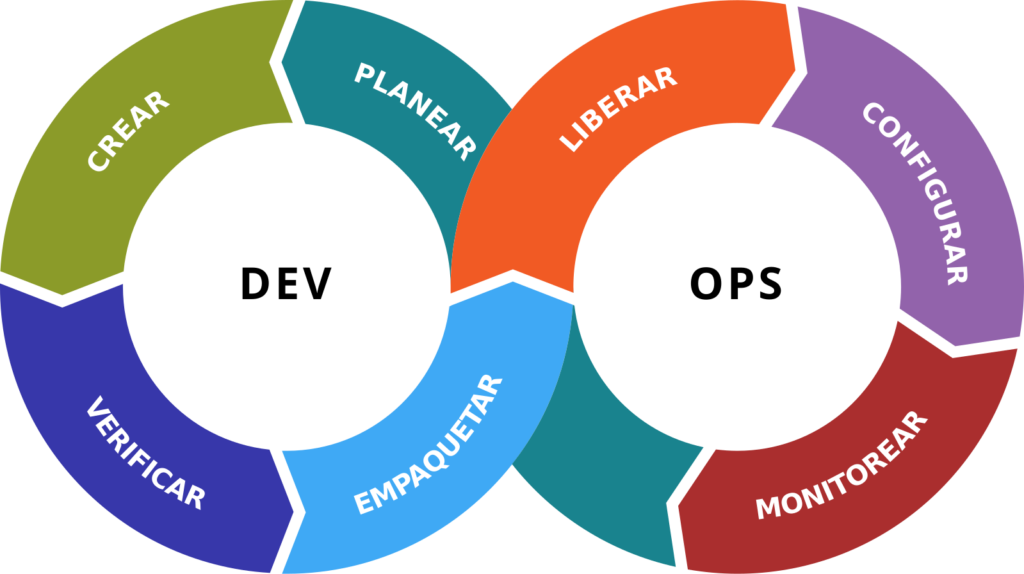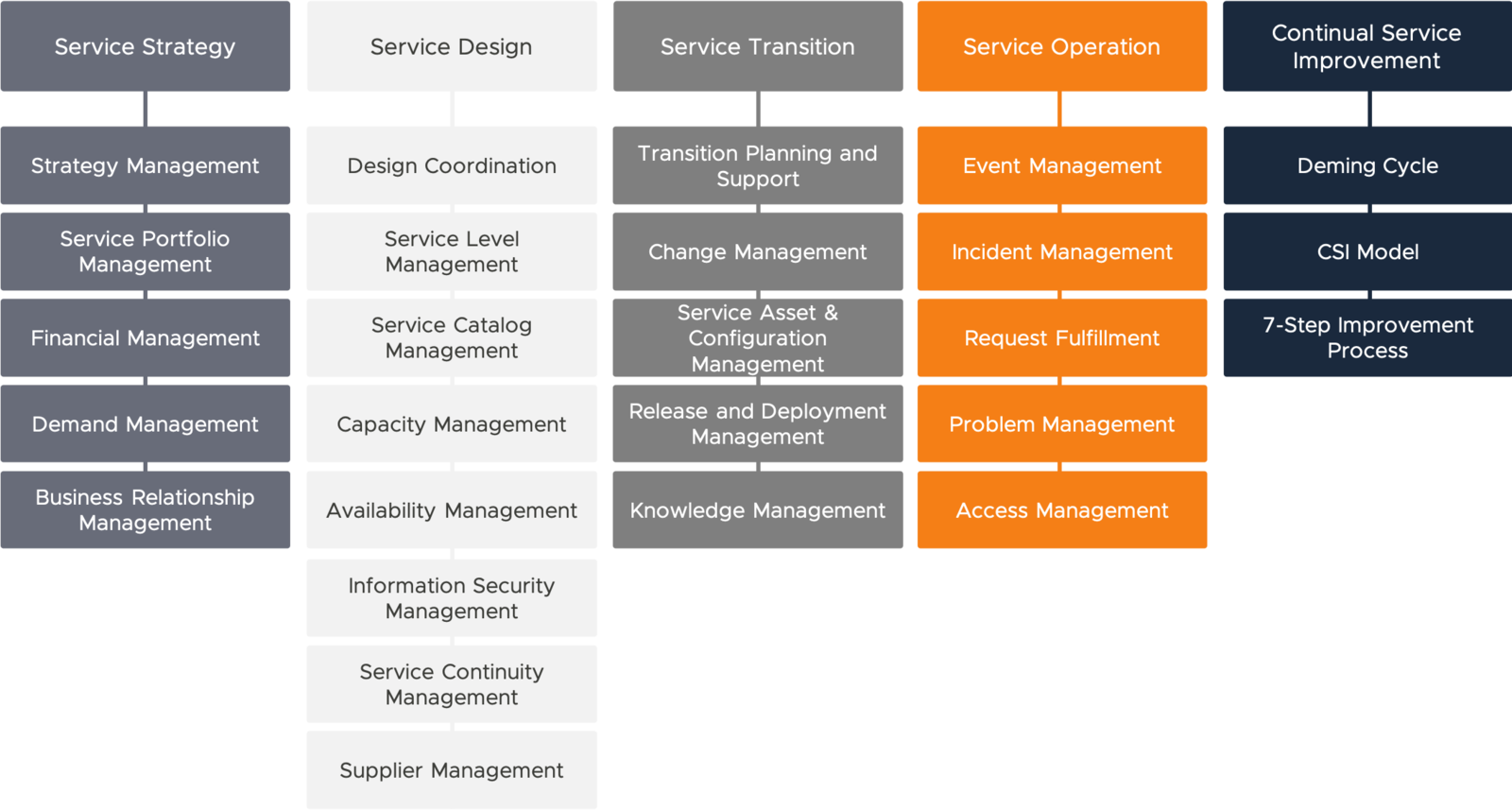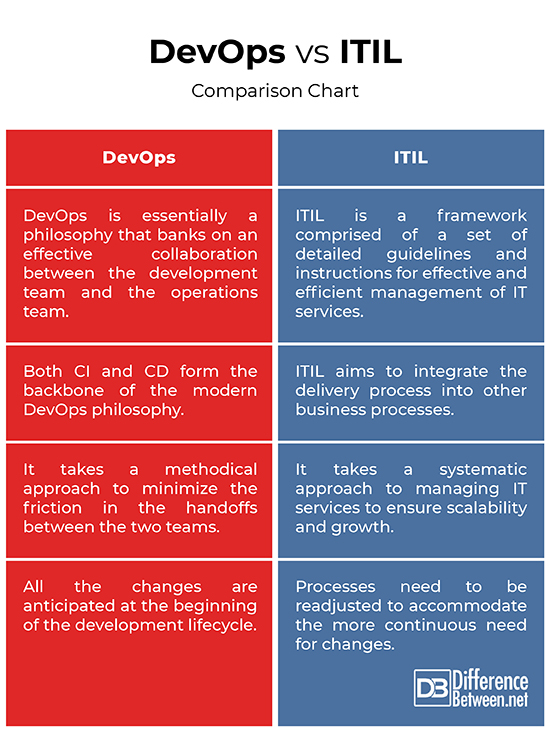Difference Between DevOps and ITIL
Although, DevOps and ITIL are two different paradigms for delivering and managing IT services within an organization, their fundamentals and core principles are not so different after all. Both aim for better collaboration and improved efficiency, but follow a different approach. There is a common misconception regarding both being mutually exclusive, which is not true. In reality, they complement each other really well. But they do have their fair share of differences as well. Let’s take a look.

DevOps
DevOps is a new corporate culture, a collaborative effort that encourages the development (Dev) team and the IT operations (Ops) team to work together from start to deployment and all the way to production. DevOps is not a technology, but a set of ideas and practices that intends to increase business value and productivity through quality service and timely delivery. This is a bold move that aims to bring transparency and collaboration within an organization by creating a better working relationship between the developers and the operations teams. This allows organizations to develop and deliver products and services much faster and efficiently than they can with conventional software development approaches. This not only helps minimize the redundancy in development processes but also ensures a smooth decision-making process, thereby driving higher business results.

ITIL
ITIL, short for Information Technology Infrastructure Library, is a framework comprised of a set of detailed guidelines and instructions for delivering IT services. ITIL is the most recognized framework for IT service management (ITSM) in the world. It is the most widely used approach to addressing service management challenges that aims to unite all areas of IT service provision toward a common goal – to deliver value to business. ITIL offers robust, mature practices that are applicable to all types of service organizations. These practices were put together over time to form the best practices which enable you to provide the best services possible. ITIL is basically an approach of how to do IT service management in the best possible way to meet the needs of a business. The goal is to align IT services with the needs of the business. You can pick and choose what processes work best for you and your business.
Difference between DevOps and ITIL
Role
– DevOps is essentially a philosophy that banks on an effective collaboration between the development team and the operations team for faster and efficient delivery and to ensure better productivity and profitable business results. DevOps originated in the Agile environment. The story is somehow different with the ITIL, which is a framework comprised of a set of detailed guidelines and instructions for IT service management (ITSM) that formalizes many aspects of the software life cycle. DevOps is more about how to do and ITIL is about what to do.
Delivery
– DevOps aims to create a standardized environment between development and production for increased coordination and faster delivery, thereby minimizing the friction in the handoffs between the two teams. Both CI and CD form the backbone of the modern DevOps philosophy. ITIL takes a different approach for software delivery and aims to integrate the delivery process into other business processes. It takes a systematic approach to managing IT services, mitigating risks, establishing cost-effective practices, and stabilizing the work environment for scalability and growth.
Change Management
– ITIL offers a set of ITSM best practices, including change management to address service management challenges the best possible way to meet the needs of a business. The ITIL roles would require processes to be readjusted so that to accommodate the more continuous need for changes. This involves determining change advisory board (CAB) leadership. The approach to change is very different with DevOps. According to DevOps, all changes are encouraged unless they incur greater risk and the increased probability of adverse business impact. So, all the changes are anticipated at the beginning of the development lifecycle.
Goal
– The goal of DevOps is to improve collaboration and coordination within an organization by creating a better working relationship between the developers and the operations teams, and automating a continuous delivery pipeline. Unlike ITIL which focuses on the effective management of industry’s best ITSM practices, DevOps relies on the power of communication and cooperation to reduce the risk of deployments and ensure higher release quality. The ultimate goal is to increase ROI, cash flow and overall profit by mitigating the bottlenecks within an organization. The goal of ITIL is to standardize the ITSM structure within an organization for the efficient and effective delivery of IT Services.
DevOps vs. ITIL: Comparison Chart

Summary of DevOps vs. ITIL
DevOps is a relatively new movement and many organizations are still in their early stages of adoption, whereas many organizations have already invested in more established methodologies and practices, such as the ITIL. From the beginning, ITIL has been regarded as a more systematic or structures approach to IT service management. Despite common misconceptions and confusions, ITIL is not in contradiction with DevOps philosophy. In fact, both are different paradigms for delivering and managing IT services that can coexist within an organization. And many ITIL practices translate directly into corresponding DevOps practices.
- Difference Between Caucus and Primary - June 18, 2024
- Difference Between PPO and POS - May 30, 2024
- Difference Between RFID and NFC - May 28, 2024
Search DifferenceBetween.net :
Leave a Response
References :
[0]Verona, Joakim. Practical DevOps (Second Edition). Birmingham, United Kingdom: Packt Publishing, 2018. Print
[1]Farooqui, Shamayel M. Enterprise DevOps Framework: Transforming IT Operations. New York, United States: Apress, 2018. Print
[2]Ravichandran, Aruna et al. DevOps for Digital Leaders: Reignite Business with a Modern DevOps-Enabled Software Factory. New York, United States: Apress, 2016. Print
[3]Bass, Len et al. DevOps: A Software Architect's Perspective. Massachusetts, United States: Addison-Wesley, 2015. Print
[4]Davis, Jennifer and Ryn Daniels. Effective DevOps: Building a Culture of Collaboration, Affinity, and Tooling at Scale. California, United States: O'Reilly Media, 2016. Print
[5]Image credit: https://commons.wikimedia.org/wiki/File:Devops-toolchain-es.svg
[6]Image credit: https://commons.wikimedia.org/wiki/File:ITIL_Processes.png
